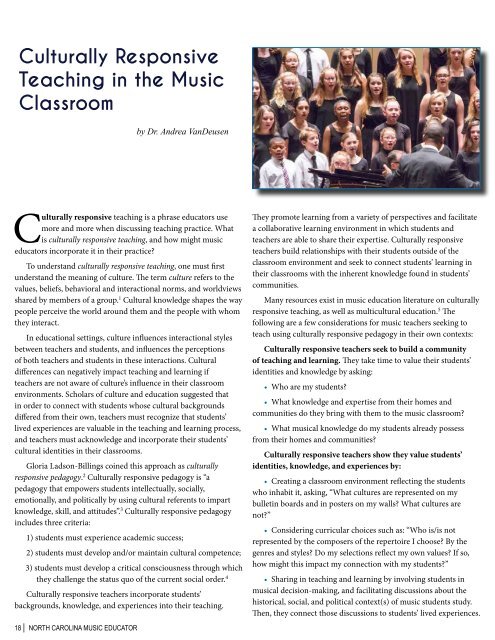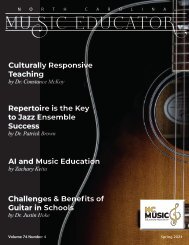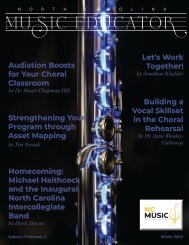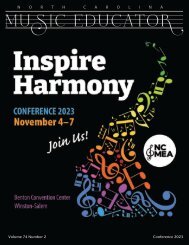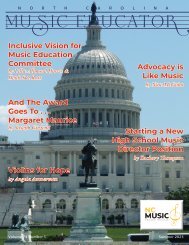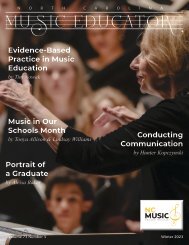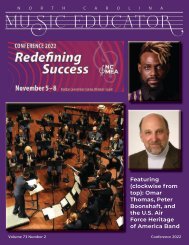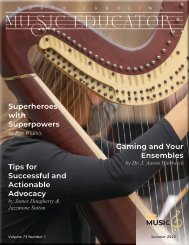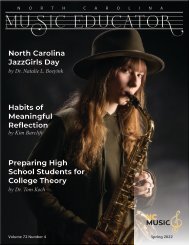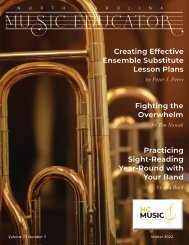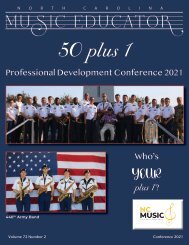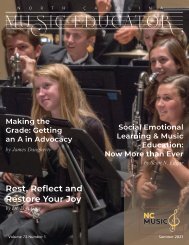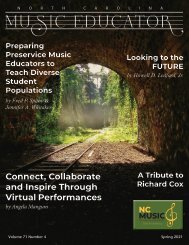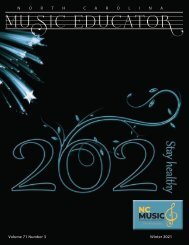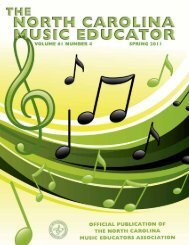NC Music Educator Winter 2018
North Carolina Music Educators Association Journal Winter 2018
North Carolina Music Educators Association Journal Winter 2018
- TAGS
- advocacy
- music-education
- ncmea
You also want an ePaper? Increase the reach of your titles
YUMPU automatically turns print PDFs into web optimized ePapers that Google loves.
Culturally Responsive<br />
Teaching in the <strong>Music</strong><br />
Classroom<br />
by Dr. Andrea VanDeusen<br />
Culturally responsive teaching is a phrase educators use<br />
more and more when discussing teaching practice. What<br />
is culturally responsive teaching, and how might music<br />
educators incorporate it in their practice?<br />
To understand culturally responsive teaching, one must first<br />
understand the meaning of culture. The term culture refers to the<br />
values, beliefs, behavioral and interactional norms, and worldviews<br />
shared by members of a group. 1 Cultural knowledge shapes the way<br />
people perceive the world around them and the people with whom<br />
they interact.<br />
In educational settings, culture influences interactional styles<br />
between teachers and students, and influences the perceptions<br />
of both teachers and students in these interactions. Cultural<br />
differences can negatively impact teaching and learning if<br />
teachers are not aware of culture’s influence in their classroom<br />
environments. Scholars of culture and education suggested that<br />
in order to connect with students whose cultural backgrounds<br />
differed from their own, teachers must recognize that students’<br />
lived experiences are valuable in the teaching and learning process,<br />
and teachers must acknowledge and incorporate their students’<br />
cultural identities in their classrooms.<br />
Gloria Ladson-Billings coined this approach as culturally<br />
responsive pedagogy. 2 Culturally responsive pedagogy is “a<br />
pedagogy that empowers students intellectually, socially,<br />
emotionally, and politically by using cultural referents to impart<br />
knowledge, skill, and attitudes”. 3 Culturally responsive pedagogy<br />
includes three criteria:<br />
1) students must experience academic success;<br />
2) students must develop and/or maintain cultural competence;<br />
3) students must develop a critical consciousness through which<br />
they challenge the status quo of the current social order. 4<br />
Culturally responsive teachers incorporate students’<br />
backgrounds, knowledge, and experiences into their teaching.<br />
They promote learning from a variety of perspectives and facilitate<br />
a collaborative learning environment in which students and<br />
teachers are able to share their expertise. Culturally responsive<br />
teachers build relationships with their students outside of the<br />
classroom environment and seek to connect students’ learning in<br />
their classrooms with the inherent knowledge found in students’<br />
communities.<br />
Many resources exist in music education literature on culturally<br />
responsive teaching, as well as multicultural education. 5 The<br />
following are a few considerations for music teachers seeking to<br />
teach using culturally responsive pedagogy in their own contexts:<br />
Culturally responsive teachers seek to build a community<br />
of teaching and learning. They take time to value their students’<br />
identities and knowledge by asking:<br />
• Who are my students?<br />
• What knowledge and expertise from their homes and<br />
communities do they bring with them to the music classroom?<br />
• What musical knowledge do my students already possess<br />
from their homes and communities?<br />
Culturally responsive teachers show they value students’<br />
identities, knowledge, and experiences by:<br />
• Creating a classroom environment reflecting the students<br />
who inhabit it, asking, “What cultures are represented on my<br />
bulletin boards and in posters on my walls? What cultures are<br />
not?”<br />
• Considering curricular choices such as: “Who is/is not<br />
represented by the composers of the repertoire I choose? By the<br />
genres and styles? Do my selections reflect my own values? If so,<br />
how might this impact my connection with my students?”<br />
• Sharing in teaching and learning by involving students in<br />
musical decision-making, and facilitating discussions about the<br />
historical, social, and political context(s) of music students study.<br />
Then, they connect those discussions to students’ lived experiences.<br />
18 | NORTH CAROLINA MUSIC EDUCATOR


